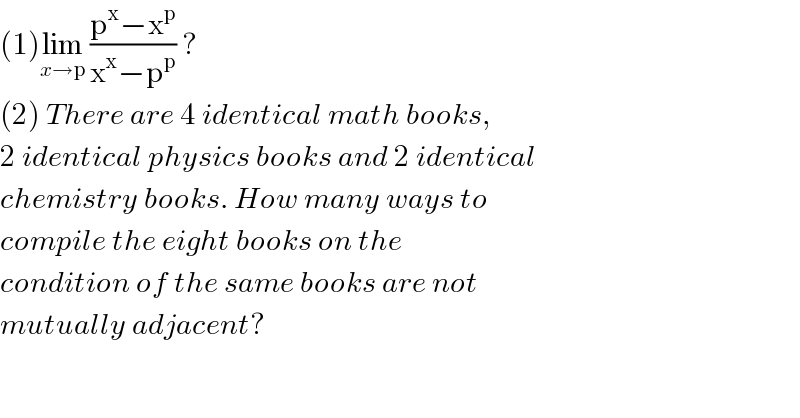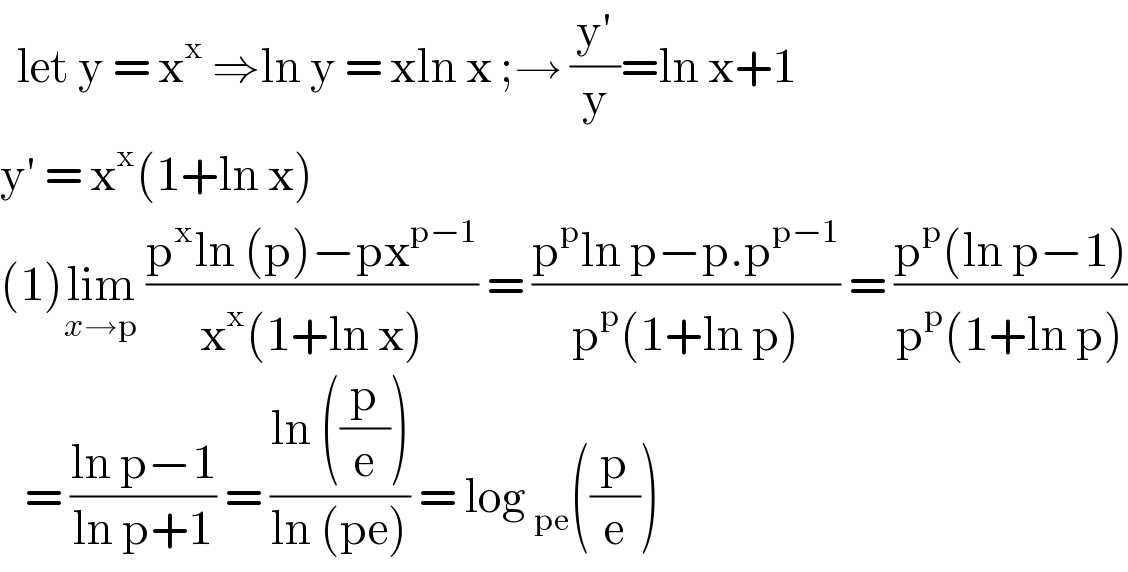Question Number 112455 by john santu last updated on 08/Sep/20

$$\left(\mathrm{1}\right)\underset{{x}\rightarrow\mathrm{p}} {\mathrm{lim}}\:\frac{\mathrm{p}^{\mathrm{x}} −\mathrm{x}^{\mathrm{p}} }{\mathrm{x}^{\mathrm{x}} −\mathrm{p}^{\mathrm{p}} }\:?\: \\ $$$$\left(\mathrm{2}\right)\:{There}\:{are}\:\mathrm{4}\:{identical}\:{math}\:{books}, \\ $$$$\mathrm{2}\:{identical}\:{physics}\:{books}\:{and}\:\mathrm{2}\:{identical} \\ $$$${chemistry}\:{books}.\:{How}\:{many}\:{ways}\:{to} \\ $$$${compile}\:{the}\:{eight}\:{books}\:{on}\:{the}\: \\ $$$${condition}\:{of}\:{the}\:{same}\:{books}\:{are}\:{not} \\ $$$${mutually}\:{adjacent}? \\ $$
Answered by bobhans last updated on 08/Sep/20

$$\:\:\mathrm{let}\:\mathrm{y}\:=\:\mathrm{x}^{\mathrm{x}} \:\Rightarrow\mathrm{ln}\:\mathrm{y}\:=\:\mathrm{xln}\:\mathrm{x}\:;\rightarrow\:\frac{\mathrm{y}'}{\mathrm{y}}=\mathrm{ln}\:\mathrm{x}+\mathrm{1} \\ $$$$\mathrm{y}'\:=\:\mathrm{x}^{\mathrm{x}} \left(\mathrm{1}+\mathrm{ln}\:\mathrm{x}\right) \\ $$$$\left(\mathrm{1}\right)\underset{{x}\rightarrow\mathrm{p}} {\mathrm{lim}}\:\frac{\mathrm{p}^{\mathrm{x}} \mathrm{ln}\:\left(\mathrm{p}\right)−\mathrm{px}^{\mathrm{p}−\mathrm{1}} }{\mathrm{x}^{\mathrm{x}} \left(\mathrm{1}+\mathrm{ln}\:\mathrm{x}\right)}\:=\:\frac{\mathrm{p}^{\mathrm{p}} \mathrm{ln}\:\mathrm{p}−\mathrm{p}.\mathrm{p}^{\mathrm{p}−\mathrm{1}} }{\mathrm{p}^{\mathrm{p}} \left(\mathrm{1}+\mathrm{ln}\:\mathrm{p}\right)}\:=\:\frac{\mathrm{p}^{\mathrm{p}} \left(\mathrm{ln}\:\mathrm{p}−\mathrm{1}\right)}{\mathrm{p}^{\mathrm{p}} \left(\mathrm{1}+\mathrm{ln}\:\mathrm{p}\right)} \\ $$$$\:\:\:=\:\frac{\mathrm{ln}\:\mathrm{p}−\mathrm{1}}{\mathrm{ln}\:\mathrm{p}+\mathrm{1}}\:=\:\frac{\mathrm{ln}\:\left(\frac{\mathrm{p}}{\mathrm{e}}\right)}{\mathrm{ln}\:\left(\mathrm{pe}\right)}\:=\:\mathrm{log}\:_{\mathrm{pe}} \left(\frac{\mathrm{p}}{\mathrm{e}}\right) \\ $$
Answered by mr W last updated on 08/Sep/20

$$\left(\mathrm{2}\right) \\ $$$$\mathrm{2}×\frac{\mathrm{4}!}{\mathrm{2}!\mathrm{2}!}+{C}_{\mathrm{1}} ^{\mathrm{3}} ×\mathrm{2}!×\mathrm{2}!=\mathrm{24} \\ $$
